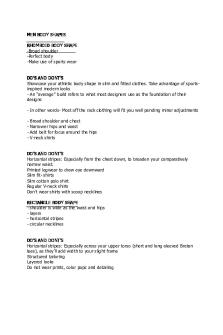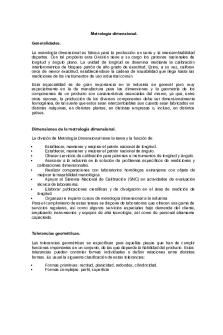Lab - Investigating Three Dimensional Shapes PDF

| Title | Lab - Investigating Three Dimensional Shapes |
|---|---|
| Author | Nidhi Karavadra |
| Course | middle english literature |
| Institution | Virtual High School |
| Pages | 3 |
| File Size | 273.5 KB |
| File Type | |
| Total Downloads | 2 |
| Total Views | 123 |
Summary
HI THIS IS A NICE DOCUMENT ITS ABOUT ENGLISH...
Description
Lab: Investigating Three-Dimensional Shapes Chemists use VSEPR theory to predict the structure of molecules. A molecule’s structure can reveal important characteristics, such as its reactivity, behaviour, and electrical conductivity. Chemists also use molecular models to visualize the structure of a molecule. In this activity, you will use VSEPR theory to predict the structure of different molecules, and then use a molecular modelling program to visualize these molecules. Purpose: To test your understanding of VSEPR theory and observe three-dimensional structures of molecules. Procedure: 1. Draw Lewis diagrams and use VSEPR theory to predict the structures and bond angles of the following molecules: HBr, BCl2F, CH2O, CH4, O2, NH3, PF5, SCl6, H2S, BeCl2. 2. Go to https://phet.colorado.edu/sims/html/molecule-shapes/latest/moleculeshapes_en.html and select Model. Build digital models of your molecules. 3. For each molecule, take a screenshot or sketch the molecule and fill in the table below. The first molecule is done for you. Molecule
Lewis Diagram
HBr
AXE VSEPR classification Shape (central atom) AXE3 Linear
180 o
BCl2F
AX3
120 o
Trigonal planar
Bond Angles
Screenshot / Sketch of molecule
CH2O
AX3
Trigonal planar
120 o
CH4
AX4
Tetrahedral
109.5 o
O2
N/A
Linear
180 o
NH3
AX3E
Trigonal pyramidal
107 o
PF5
AX5
Trigonal 90 o, bipyramidal 120 o
SCl6
AX6
Octahedral
90 o
H 2S
AX2E2
Bent
104.5 o
BeCl2
AX2
Linear
180 o...
Similar Free PDFs

Lab number three
- 8 Pages

Analisis dimensional
- 2 Pages

Lab-2- three phase circuits
- 19 Pages

Analisis Dimensional
- 5 Pages

MEN BODY Shapes
- 4 Pages

Metrología dimensional
- 7 Pages

Analisis-dimensional
- 2 Pages

Dimensional analysis
- 9 Pages
Popular Institutions
- Tinajero National High School - Annex
- Politeknik Caltex Riau
- Yokohama City University
- SGT University
- University of Al-Qadisiyah
- Divine Word College of Vigan
- Techniek College Rotterdam
- Universidade de Santiago
- Universiti Teknologi MARA Cawangan Johor Kampus Pasir Gudang
- Poltekkes Kemenkes Yogyakarta
- Baguio City National High School
- Colegio san marcos
- preparatoria uno
- Centro de Bachillerato Tecnológico Industrial y de Servicios No. 107
- Dalian Maritime University
- Quang Trung Secondary School
- Colegio Tecnológico en Informática
- Corporación Regional de Educación Superior
- Grupo CEDVA
- Dar Al Uloom University
- Centro de Estudios Preuniversitarios de la Universidad Nacional de Ingeniería
- 上智大学
- Aakash International School, Nuna Majara
- San Felipe Neri Catholic School
- Kang Chiao International School - New Taipei City
- Misamis Occidental National High School
- Institución Educativa Escuela Normal Juan Ladrilleros
- Kolehiyo ng Pantukan
- Batanes State College
- Instituto Continental
- Sekolah Menengah Kejuruan Kesehatan Kaltara (Tarakan)
- Colegio de La Inmaculada Concepcion - Cebu







